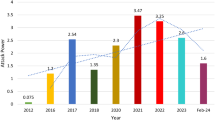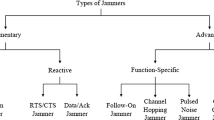Abstract
Non Orthogonal Multiple Access (NOMA) successfully drew attention to the deployment of 5th Generation (5G) wireless communication systems, and it is now considered a significant technology in 5G communications. The primary enhancement in 5G is the speed, which may be 100 times faster than 4G. Due to the rising number of internal or external attacks on the Network, wireless intrusion detection systems are a vital aspect of any system connected to the Internet, and 5G will demand considerable improvements in data rate and security. In this paper, we have built a simulator for NOMA and applied a dropping attack to extract a dataset from the simulation model. The accuracy for detecting dropping attacks using the extracted data after applying ML algorithms was 95.7% for LR. Furthermore, this work suggests a methodology for wireless cyberattack detection in 5G networks based on applying several ML and DL techniques such as Decision Trees, KNN, Multi-class Decision Jungle, Multi-class Decision Forest, and Multi-class Neural Network. The proposed work is implemented and tested using a comprehensive Wi-Fi network benchmark dataset. The conducted experiments resulted in an outstanding performance with an accuracy of 99% for the KNN algorithm and 93% for DF and Neural Network.
















Similar content being viewed by others
Data Availability
data is available from the authors upon reasonable request.
Change history
18 October 2022
A Correction to this paper has been published: https://doi.org/10.1007/s11042-022-14059-5
References
Abusukhon A, AlZu’bi S (2020) New direction of cryptography: a review on text-to-image encryption algorithms based on rgb color value. In: 2020 seventh international conference on software defined systems, (SDS), IEEE, pp 235–239
Ahmad R, Alsmadi I (2021) Machine learning approaches to iot security: A systematic literature review. Inter Things 14:100365
Ahmad I, Kumar T, Liyanage M, Okwuibe J, Ylianttila M, Gurtov A (2018) Overview of 5g security challenges and solutions. IEEE Commun Mag 2(1):36–43
Akbar A, Jangsher S, Bhatti FA (2021) Noma and 5g emerging technologies: a survey on issues and solution techniques. Comput Netw 190:107950
Al Ridhawi I, Aloqaily M, Boukerche A, Jararweh Y (2021) Enabling intelligent iocv services at the edge for 5g networks and beyond. IEEE Trans Intell Transp Syst 22(8):5190–5200
Al Shinwan M, Abualigah L, Huy T-D, Younes Shdefat A, Altalhi M, Kim C, El-Sappagh S, Abd Elaziz M, Kwak KS (2022) An efficient 5g data plan approach based on partially distributed mobility architecture. Sensors 22 (1):349
Al-Arjan A, Rasmi M, AlZu’bi S, et al. (2021) Intelligent security in the era of ai: the key vulnerability of rc4 algorithm. In: 2021 international conference on information technology, (ICIT), IEEE, pp 691–694
Al-Falahy N, Alani OY (2017) Technologies for 5g networks: challenges and opportunities. IT Professional 19(1):12–20
Al-Obiedollah H, Salameh HB, Abdel-Razeq S, Hayajneh A, Cumanan K, Jararweh Y (2022) Energy-efficient opportunistic multi-carrier noma-based resource allocation for beyond 5g (b5g) networks. Simul Model Pract Theory 116:102452
Al-Zu’bi S, Hawashin B, Mughaid A, Baker T (2021) Efficient 3d medical image segmentation algorithm over a secured multimedia network. Multimed Tools Appl 80(11):16887–16905
AlZu’bi S, Jararweh Y, Al-Zoubi H, Elbes M, Kanan T, Gupta B (2019) Multi-orientation geometric medical volumes segmentation using 3d multiresolution analysis. Multimed Tools Appl 78(17):24223–24248
Alasal SA, Alsmirat M, Baker QB, Alzu’bi S, et al. (2020) Lumbar disk 3d modeling from limited number of mri axial slices. Inter J Electr Comput Eng 10(4):4101
Alkhatib AA, Abu Maria K, Alzu’bi S, Abu Maria E (2022) Novel system for road traffic optimisation in large cities, IET Smart Cities
Alzubi S, Hawashin B, Mughaid A, Jararweh Y (2020) Whats trending? an efficient trending research topics extractor and recommender. In: 2020 11th international conference on information and communication systems, (ICICS), IEEE, pp 191–196
Aminanto ME, Choi R, Tanuwidjaja HC, Yoo PD, Kim K (2017) Deep abstraction and weighted feature selection for wi-fi impersonation detection. IEEE Trans Inform Forensics Secur 13(3):621–636
Aminanto ME, Tanuwidjaja HC, Yoo PD, Kim K (2017) Wi-fi intrusion detection using weighted-feature selection for neural networks classifier. In: 2017 international workshop on big data and information security, (IWBIS), IEEE, pp 99–104
Aqel D, Al-Zubi S, Mughaid A, Jararweh Y (2021) Extreme learning machine for plant diseases classification: a sustainable approach for smart agriculture. Cluster Computing, pp 1–14
Arachchillage USSS, Jayakody DNK, Biswash SK, Dinis R (2018) Recent advances and future research challenges in non-orthogonal multiple access for 5g networks. In: 2018 IEEE 87th Vehicular Technology Conference (VTC Spring), IEEE, pp 1–6
Arfaoui G, Bisson P, Blom R, Borgaonkar R, Englund H, Félix E, Klaedtke F, Nakarmi PK, Näslund M, O’Hanlon P, Papay J, Suomalainen J, Surridge M, Wary J-P, Zahariev A (2018) A security architecture for 5g networks. IEEE Access 6:22466–22479
Bengag A, Moussaoui O, Moussaoui M (2019) A new ids for detecting jamming attacks in wban. In: 2019 third international conference on intelligent computing in data sciences, (ICDS), IEEE, pp 1–5
Bounouni M, Bouallouche-Medjkoune L, Beraza A, Daoud A (2021) Eliminating selective dropping attack in mobile ad hoc network. Wirel Pers Commun, pp 1–18
Dawoud A, Shahristani S, Raun C (2018) Deep learning for network anomalies detection. In: 2018 International Conference on Machine Learning and Data Engineering (iCMLDE), IEEE, pp 149–153
De Capitani di Vimercati S, Foresti S, Jajodia S, Livraga G, Paraboschi S, Samarati P (2021) An authorization model for query execution in the cloud. The VLDB Journal, pp 1–25
Fang H, Wang X, Tomasin S (2019) Machine learning for intelligent authentication in 5g and beyond wireless networks. IEEE Wirel Commun 26(5):55–61
Forland MK, Kralevska K, Garau M, Gligoroski D (2019) Preventing ddos with sdn in 5g. In: 2019 IEEE globecom workshops, (GC Wkshps), IEEE, pp 1–7
Hnaif A, Jaber KM, Alia MA, Daghbosheh M (2021) Parallel scalable approximate matching algorithm for network intrusion detection systems. Int Arab J Inf Technol 18(1):77–84
Intelligence NM (2021) Ai reflections in 2021. Evol Comput 3:9–15
Khan R, Kumar P, Jayakody DNK, Liyanage M (2019) A survey on security and privacy of 5g technologies: Potential solutions, recent advancements, and future directions. IEEE Commun Surv Tut 22(1):196–248
Koh PW, Steinhardt J, Liang P (2021) Stronger data poisoning attacks break data sanitization defenses. Machine Learning, pp 1–47
Kumar A, Varadarajan V, Kumar A, Dadheech P, Choudhary SS, Kumar VA, Panigrahi BK, Veluvolu KC (2021) Black hole attack detection in vehicular ad-hoc network using secure aodv routing algorithm. Microprocess Microsyst 80:103352
Lafi M, Hawashin B, AlZu’bi S (2021) Eliciting requirements from stakeholders’ responses using natural language processing. Comput Model Eng Sci 127 (1):99–116
Lam J, Abbas R (2020) Machine learning based anomaly detection for 5g networks, arXiv:2003.03474
Maimó LF, Gómez Á LP, Clemente FJG, Pérez MG, Pérez GM (2018) A self-adaptive deep learning-based system for anomaly detection in 5g networks. IEEE Access 6:7700–7712
Malekzadeh M, Ghani AAA, Subramaniam S, Desa JM (2011) Validating reliability of omnet++ in wireless networks dos attacks: Simulation vs. testbed. Int J Netw Secur 13(1):13–21
Malik A, Khan MZ, Faisal M, Khan F, Seo J-T (2022) An efficient dynamic solution for the detection and prevention of black hole attack in vanets. Sensors 22(5):1897
Marashdeh Z, Suwais K, Alia M (2021) A survey on sql injection attack: detection and challenges. In: 2021 international conference on information technology, (ICIT), IEEE, pp 957–962
Mitrokotsa A, Mavropodi R, Douligeris C (2006) Intrusion detection of packet dropping attacks in mobile ad hoc networks. In: Proceedings of the international conference on intelligent systems and computing: theory and applications, pp 111–118
Mughaid A, Al-Zu’bi S, Al Arjan A, Al-Amrat R, Alajmi R, Zitar RA, Abualigah L (2022) An intelligent cybersecurity system for detecting fake news in social media websites. Soft Comput 26(12):5577–5591
Mughaid A, AlZu’bi S, Hnaif A, Taamneh S, Alnajjar A, Elsoud EA (2022) An intelligent cyber security phishing detection system using deep learning techniques. Cluster Computing, pp 1–10
Muro Barbé M (2020) Development of a MATLAB application to generate NOMA-CAP 5G signals (Bachelor’s thesis, Universitat Politècnica de Catalunya).
Obeidat I, Mughaid A, Alzoubi S (2019) A Secure Encrypted Protocol for Clients’ Handshaking in the Same Network.
Otair M, Ibrahim OT, Abualigah L, Altalhi M, Sumari P (2022) An enhanced grey wolf optimizer based particle swarm optimizer for intrusion detection system in wireless sensor networks. Wirel Netw 28(2):721–744
Oyelade ON, Ezugwu AE, Almutairi MS, Saha AK, Abualigah L, Chiroma H (2022) A generative adversarial network for synthetization of regions of interest based on digital mammograms. Sci Rep 12(1):1–30
Pathan F, Shringare K (2019) Analysis of 5g mobile technologies and ddos defense. Inter Res J Eng Technol 6(6):2973–2979
Ran J, Ji Y, Tang B (2019) A semi-supervised learning approach to ieee 802.11 network anomaly detection. In: 2019 IEEE 89th Vehicular technology conference (VTC2019-Spring), IEEE, pp 1–5
Safaldin M, Otair M, Abualigah L (2021) Improved binary gray wolf optimizer and svm for intrusion detection system in wireless sensor networks. J Ambient Intell Human Comput 12(2):1559–1576
Thanthrige USKPM, Samarabandu J, Wang X (2016) Machine learning techniques for intrusion detection on public dataset. In: 2016 IEEE canadian conference on electrical and computer engineering, (CCECE), IEEE, pp 1–4
Vaca FD, Niyaz Q (2018) An ensemble learning based wi-fi network intrusion detection system (wnids). In: 2018 IEEE 17th international symposium on network computing and applications, (NCA), IEEE, pp 1–5
Wang S, Li B, Yang M, Yan Z (2018) Intrusion detection for wifi network: A deep learning approach. In: International wireless internet conference, Springer, pp 95–104
Zhang S, Wang Y, Zhou W (2019) Towards secure 5g networks: a survey. Comput Netw 162:106871
Author information
Authors and Affiliations
Corresponding author
Ethics declarations
Conflict of Interests
The authors declare that there is no conflict of interest regarding the publication of this paper.
Additional information
Publisher’s note
Springer Nature remains neutral with regard to jurisdictional claims in published maps and institutional affiliations.
The original online version of this article was revised: The original publication of this article contains incorrect affiliations of the author "Laith Abualigah".
Rights and permissions
Springer Nature or its licensor holds exclusive rights to this article under a publishing agreement with the author(s) or other rightsholder(s); author self-archiving of the accepted manuscript version of this article is solely governed by the terms of such publishing agreement and applicable law.
About this article
Cite this article
Mughaid, A., AlZu’bi, S., Alnajjar, A. et al. Improved dropping attacks detecting system in 5g networks using machine learning and deep learning approaches. Multimed Tools Appl 82, 13973–13995 (2023). https://doi.org/10.1007/s11042-022-13914-9
Received:
Revised:
Accepted:
Published:
Issue Date:
DOI: https://doi.org/10.1007/s11042-022-13914-9




